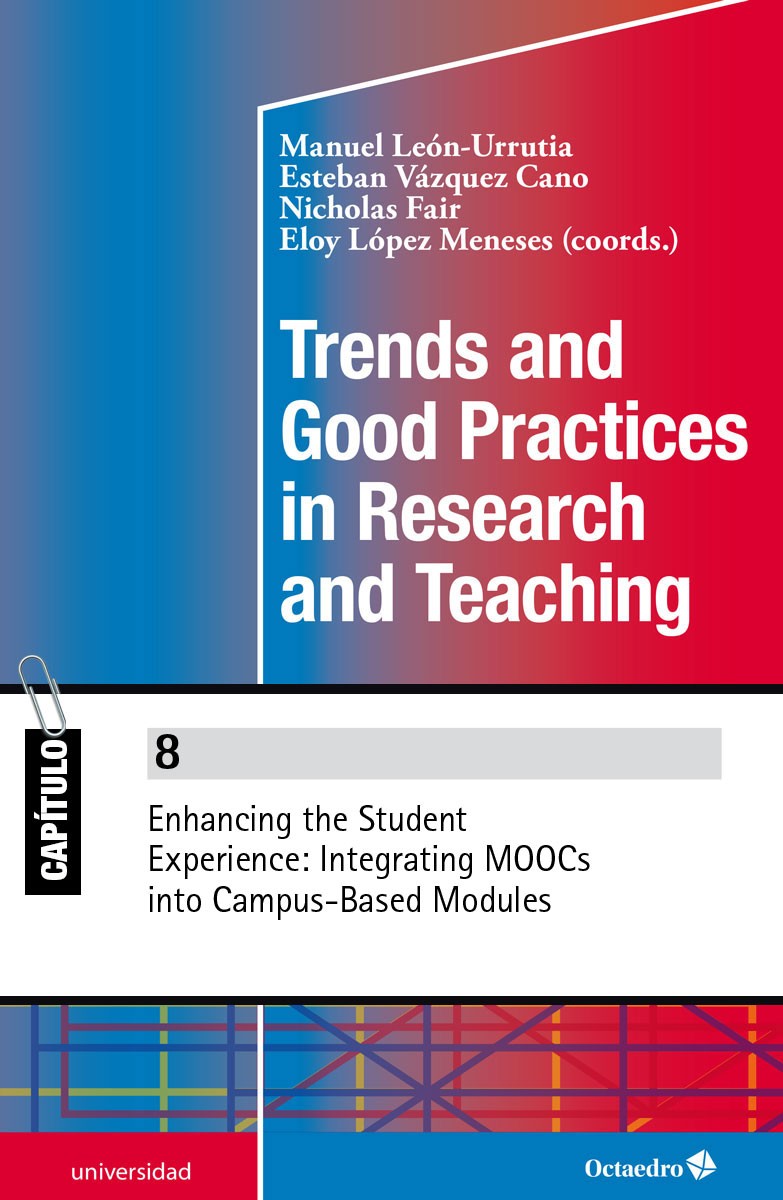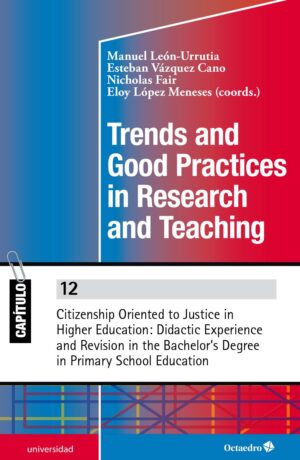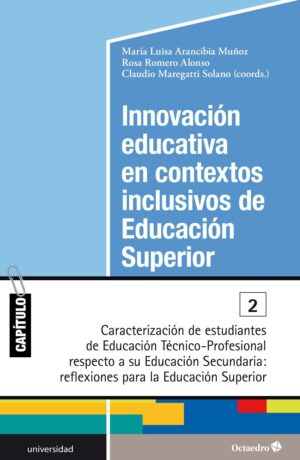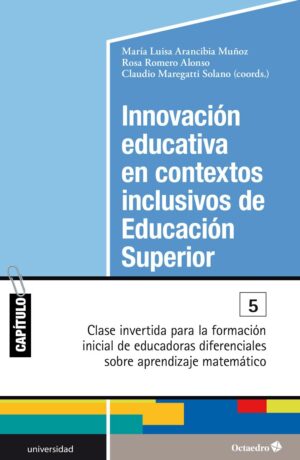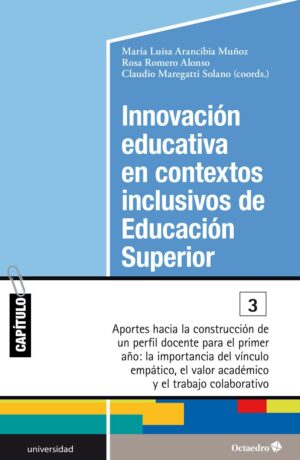FICHA TÉCNICA
Fecha de publicación:
01/01/2020
DOI: https://doi.org/10.36006/16184-08
Título del libro: Trends and Good Practices in Research and Teaching
URL del libro: Trends and Good Practices in Research and Teaching
ISBN:
DOI del libro: https://doi.org/10.36006/16184
Abstract
Massive Open Online Courses (MOOCs) are continuing to expand in Higher Education Institutions (HEIs). In some cases, these courses are becoming integrated into institutions, to such an extent that they are being incorporated in the on-campus curriculum. There are a range of benefits which learners can enjoy when undertaking a university module in which participating in a MOOC is part of the syllabus, such as participating in wider learning communities, and accessing state-of-the-art learning materials. However, at the moment it is not easy to evaluate the outcome of integrating MOOCs into traditional university modules, as there is not yet a great deal of research reporting on the area. To address this research gap, this paper reports on a socio-technical intervention in which 46 undergraduates on the Online Social Networks module at the University of Southampton also had the Learning in the Network Age and Power of Social Media FutureLearn MOOCs, and an offline support programme, integrated into the syllabus for revision purposes. Learners were surveyed before the module started to establish their prior experience of and attitudes to MOOCs. In order to reach an assessment of the effectiveness of the intervention, the module final grades and result profile, the learners assessed reflections and the anonymized end-of-module feedback forms were analyzed. The module grade average increased by three percent, moving up a band, and the number of top grades awarded doubled. However, learner reflections and feedback were rather more mixed, with equal numbers of learners finding MOOCs of great value for deepening understanding as those who gained little benefit from the experience. Such diversity of outcomes led the researchers to a discussion of the barriers affecting a socio-technical approach to HE teaching and learning.
Palabras clave
Autores
Cómo citar
Fair, N., Harris, L., León-Urrutia, M. (2019). Enhancing the Student Experience: Integrating MOOCs into Campus-Based Modules. En León-Urrutia, M., Vázquez Cano, E., Fair, N., López Meneses, E. (coords.) Trends and Good Practices in Research and Teaching. A Spanish-English Collaboration. Barcelona: Octaedro. https://doi.org/10.36006/16184-08
Referencias bibliográficas
- Andone, D., Mihaescu, V., Ternauciuc, A., & Vasiu, R. (2015). Integrating MOOCs in Traditional Higher Education. In Proceedings of the Third European Summit of MOOCs Stakeholders (pp. 71-75).
- Berners-Lee, T., Fischetti, M., & Foreword By-Dertouzos, M. L., 2000. Weaving the Web: The original design and ultimate destiny of the World Wide Web by its inventor. Harper Information.
- Bijker, W. E., Hughes, T. P., & Pinch, T. J. (eds.) (1987). The social construction of technological systems: New directions in the sociology and history of technology.
- Bruff, D. O., Fisher, D. H., McEwen, K. E., & Smith, B. E. (2013). Wrapping a MOOC: Student Perceptions of an Experiment in Blended Learning, MERLOT, Journal of Online Learning and Teaching, 9 (2), 187-199.
- Callon, M. (1986). Some elements of a sociology of translation: domestication of the scallops and the fishermen of St. Brieuc Bay, Power, action, and belief: A new sociology of knowledge, 32, 196-223.
- Castells, M., 1996. The network society (vol. 469). Oxford: Blackwell.
- Caulfield, M., Collier, A., & Halawa, S. (2013). Rethinking online community in MOOCs used for blended learning, Educause Review Online, 1-9. Available at <http://er.educause.edu/articles/2013/10/rethinking-online-community-in-moocs-used-for-blended-learning>.
- Carr, W. & Kemmis, S. (2003). Becoming critical: education knowledge and action research. Routledge.
- Cummings, T. G. (1978). Self-regulating work groups: A socio-technical synthesis. Academy of Management Review, 3 (3), 625-634.
- Davis, H., Dickens, K., León-Urrutia, M., Sánchez Vera, M. del M., & White, S. (2014). MOOCs for Universities and Learners An analysis of motivating factors. In Proceedings of the 6th International Conference on Computer Supported Education. Barcelona. Available at <http://eprints.soton.ac.uk/363714/1/DavisEtAl2014MOOCsCSEDUFinal.pdf>.
- Davis, H. C., Halford, S. J., and Gibbins, N. (2012). Digital natives? Investigating young people’s critical skills in evaluating web based information. In Proceedings of the 4th Annual ACM Web Science Conference. ACM, pp. 78-81.
- Downes, S. (2006). Learning networks and connective knowledge, Collective Intelligence and Elearning, 20, 1-26.
- — (2007). What Connectivism is. Available at <http://halfanhour.blogspot.co.uk/2007/02/what-connectivism-is.html>.
- — (2008). Places to GO: Connectivism & connective knowledge. Innovate, 5 (1).
- Garrison, D. R. & Vaughan, N. D. (2008). Blended learning in higher education: Framework, principles, and guidelines. John Wiley & Sons.
- Geels, F. W. (2002). Technological transitions as evolutionary reconfiguration processes: a multi-level perspective and a case-study, Research Policy, 31 (8), 1257-1274.
- Goodyear, P. & Retalis, S. (2010). Technology-enhanced learning. (Sense publishers).
- Goodyear, P., Banks, S., Hodgson, V., & McConnell, D. (eds.) (2006). Advances in research on networked learning (vol. 4). Springer Science & Business Media.
- Griffiths, R. (2013). MOOCs in the classroom? In Haggard, S. (ed.), The maturing of the MOOC (p. 9). doi: http://doi.org/10.18665/sr.24658.
- Haggard, S., Brown, S., Mills, R., Tait, A., Warburton, S., Lawton, W., & Angulo, T. (2013). The maturing of the MOOC: Literature review of massive open online courses and other forms of online distance learning. Department for Business, Innovation and Skills, UK Government.
- Hao, Y. (2014). Exploring Undergraduate Students’ Perceptions of MOOCs. In World Conference on E-Learning in Corporate, Government, Healthcare, and Higher Education, vol. 2014, pp. 789-792. Available at <http://www.editlib.org/p/148807/>.
- Holotescu, C., Grosseck, G., Cretu, V., & Naaji, A. (2014). Integrating MOOCs in blended courses. In Let’S Build the Future Through Learning Innovation!, vol. 1, pp. 243-250. doi: http://doi.org/10.12753/2066-026X-14-034.
- Hotle, S. L., & Garrow, L. A. (2016). Effects of the traditional and flipped classrooms on undergraduate student opinions and success. Journal of Professional Issues in Engineering Education and Practice, 142 (1), 5015005. doi: http://doi.org/10.1061/(ASCE)EI.1943-5541.0000259.
- Hughes, T. P. (1987). The evolution of large technological systems. In The social construction of technological systems: New directions in the sociology and history of technology, pp. 51-82.
- Illich, I (1971). Deschooling Society (chapter 6): Learning Webs. Calder & Boyars.
- Israel, M. J. (2015). Effectiveness of integrating MOOCs in traditional classrooms for undergraduate students, International Review of Research in Open and Distance Learning, 16 (5), 102-118.
- Kang, S.-C. J., Li, Y., & Tseng, C. (2016). The effect of soft classroom: A new learning environment integrating MOOCs into conventional classrooms for college students. In ASEE Annual Conference and Exposition, Conference Proceedings, vol. 2016-June, p. 14.
- Koller, D. (2012). How online courses can form a basis for on-campus teaching. Forbes.
- Latour, B. (1987). Science in Action: How to Follow Scientists and Engineers Through Society. Milton Keynes: Open University Press.
- — (1990). Technology is society made durable, The Sociological Review, 38 (S1), 103-131.
- Lave, J. (1991). Situating learning in communities of practice, Perspectives on Socially Shared Cognition, 2, 63-82.
- Lave, J. & Wenger, E. (1991). Situated learning: Legitimate peripheral participation. Cambridge University Press.
- Law, J. (1992). Notes on the theory of the actor-network: Ordering, strategy, and heterogeneity. Systems practice, 5 (4), 379-393.
- Leon, M., White, S., & White, S. (2016). MOOCs in Higher Education magazines: a content analysis of internal stakeholder perspectives. Springer. doi: <http://dx.doi.org/10.1007/978-3-319-29585-5_23>.
- Lewin, K. (1946). Action research and minority problems, Journal of Social Issues, 2 (4), 34-46.
- Lightfoot, J. (2005). Integrating emerging technologies into traditional classrooms: a ped. International Journal of Instructional Media, 32 (2), 209–224.
- Linderbaum, B. A. & Levy, P. E. (2010). The development and validation of the Feedback Orientation Scale (FOS), Journal of Management, 36 (6), 1372-1405.
- Mazur, E. (2012). The Twilight of the Lecture’, Harvard Magazine.
- Rainie, L. & Wellman, B. (2012). Networked: The new social operating system. Mit Press.
- Richardson, W. & Mancabelli, R. (2011). Personal learning networks: Using the power of connections to transform education. Solution Tree Press.
- Rodriguez, C. O. (2012). MOOCs and the AI-Stanford like courses: Two successful and distinct course formats for massive open online courses, European Journal of Open Distance and ELearning, II, 1-13. Available at <http://www.eurodl.org/?article=516>.
- Sandeen, C. (2013). Integrating MOOCS into Traditional Higher Education: The Emerging “MOOC 3.0”, Era, Change: The Magazine of Higher Learning, 45 (6), 34-39. doi: <http://doi.org/10.1080/00091383.2013.842103>.
- Sharples, M., Adams, A., Ferguson, R., Gaved, M., McAndrew, P., Rienties, B., Weller, M., & Whitelock, D. (2014). Innovating Pedagogy 2014: Open University Innovation Report 3. Milton Keynes: The Open University.
- Siemens, G. (2004). Connectivism. A learning theory for the digital age. Available at <http://www. Elearnspace. org/Articles/connectivism. htm>.
- — (2005a). Connectivism: Learning as network-creation, ASTD Learning News, 10 (1).
- — (2005b). Connectivism: A learning theory for the digital age. Chicago
- — (2014). The attack on our higher education system, and why we should welcome it, TED blog.
- Vygotsky, L (1978). Mind in Society. London: Harvard University Press.
- White, D. S. & Le Cornu, A. (2011). Visitors and Residents: A new typology for online engagement, First Monday, 16 (9).
Mostrar referencias bibliográficas
- Andone, D., Mihaescu, V., Ternauciuc, A., & Vasiu, R. (2015). Integrating MOOCs in Traditional Higher Education. In Proceedings of the Third European Summit of MOOCs Stakeholders (pp. 71-75).
- Berners-Lee, T., Fischetti, M., & Foreword By-Dertouzos, M. L., 2000. Weaving the Web: The original design and ultimate destiny of the World Wide Web by its inventor. Harper Information.
- Bijker, W. E., Hughes, T. P., & Pinch, T. J. (eds.) (1987). The social construction of technological systems: New directions in the sociology and history of technology.
- Bruff, D. O., Fisher, D. H., McEwen, K. E., & Smith, B. E. (2013). Wrapping a MOOC: Student Perceptions of an Experiment in Blended Learning, MERLOT, Journal of Online Learning and Teaching, 9 (2), 187-199.
- Callon, M. (1986). Some elements of a sociology of translation: domestication of the scallops and the fishermen of St. Brieuc Bay, Power, action, and belief: A new sociology of knowledge, 32, 196-223.
- Castells, M., 1996. The network society (vol. 469). Oxford: Blackwell.
- Caulfield, M., Collier, A., & Halawa, S. (2013). Rethinking online community in MOOCs used for blended learning, Educause Review Online, 1-9. Available at <http://er.educause.edu/articles/2013/10/rethinking-online-community-in-moocs-used-for-blended-learning>.
- Carr, W. & Kemmis, S. (2003). Becoming critical: education knowledge and action research. Routledge.
- Cummings, T. G. (1978). Self-regulating work groups: A socio-technical synthesis. Academy of Management Review, 3 (3), 625-634.
- Davis, H., Dickens, K., León-Urrutia, M., Sánchez Vera, M. del M., & White, S. (2014). MOOCs for Universities and Learners An analysis of motivating factors. In Proceedings of the 6th International Conference on Computer Supported Education. Barcelona. Available at <http://eprints.soton.ac.uk/363714/1/DavisEtAl2014MOOCsCSEDUFinal.pdf>.
- Davis, H. C., Halford, S. J., and Gibbins, N. (2012). Digital natives? Investigating young people’s critical skills in evaluating web based information. In Proceedings of the 4th Annual ACM Web Science Conference. ACM, pp. 78-81.
- Downes, S. (2006). Learning networks and connective knowledge, Collective Intelligence and Elearning, 20, 1-26.
- — (2007). What Connectivism is. Available at <http://halfanhour.blogspot.co.uk/2007/02/what-connectivism-is.html>.
- — (2008). Places to GO: Connectivism & connective knowledge. Innovate, 5 (1).
- Garrison, D. R. & Vaughan, N. D. (2008). Blended learning in higher education: Framework, principles, and guidelines. John Wiley & Sons.
- Geels, F. W. (2002). Technological transitions as evolutionary reconfiguration processes: a multi-level perspective and a case-study, Research Policy, 31 (8), 1257-1274.
- Goodyear, P. & Retalis, S. (2010). Technology-enhanced learning. (Sense publishers).
- Goodyear, P., Banks, S., Hodgson, V., & McConnell, D. (eds.) (2006). Advances in research on networked learning (vol. 4). Springer Science & Business Media.
- Griffiths, R. (2013). MOOCs in the classroom? In Haggard, S. (ed.), The maturing of the MOOC (p. 9). doi: http://doi.org/10.18665/sr.24658.
- Haggard, S., Brown, S., Mills, R., Tait, A., Warburton, S., Lawton, W., & Angulo, T. (2013). The maturing of the MOOC: Literature review of massive open online courses and other forms of online distance learning. Department for Business, Innovation and Skills, UK Government.
- Hao, Y. (2014). Exploring Undergraduate Students’ Perceptions of MOOCs. In World Conference on E-Learning in Corporate, Government, Healthcare, and Higher Education, vol. 2014, pp. 789-792. Available at <http://www.editlib.org/p/148807/>.
- Holotescu, C., Grosseck, G., Cretu, V., & Naaji, A. (2014). Integrating MOOCs in blended courses. In Let’S Build the Future Through Learning Innovation!, vol. 1, pp. 243-250. doi: http://doi.org/10.12753/2066-026X-14-034.
- Hotle, S. L., & Garrow, L. A. (2016). Effects of the traditional and flipped classrooms on undergraduate student opinions and success. Journal of Professional Issues in Engineering Education and Practice, 142 (1), 5015005. doi: http://doi.org/10.1061/(ASCE)EI.1943-5541.0000259.
- Hughes, T. P. (1987). The evolution of large technological systems. In The social construction of technological systems: New directions in the sociology and history of technology, pp. 51-82.
- Illich, I (1971). Deschooling Society (chapter 6): Learning Webs. Calder & Boyars.
- Israel, M. J. (2015). Effectiveness of integrating MOOCs in traditional classrooms for undergraduate students, International Review of Research in Open and Distance Learning, 16 (5), 102-118.
- Kang, S.-C. J., Li, Y., & Tseng, C. (2016). The effect of soft classroom: A new learning environment integrating MOOCs into conventional classrooms for college students. In ASEE Annual Conference and Exposition, Conference Proceedings, vol. 2016-June, p. 14.
- Koller, D. (2012). How online courses can form a basis for on-campus teaching. Forbes.
- Latour, B. (1987). Science in Action: How to Follow Scientists and Engineers Through Society. Milton Keynes: Open University Press.
- — (1990). Technology is society made durable, The Sociological Review, 38 (S1), 103-131.
- Lave, J. (1991). Situating learning in communities of practice, Perspectives on Socially Shared Cognition, 2, 63-82.
- Lave, J. & Wenger, E. (1991). Situated learning: Legitimate peripheral participation. Cambridge University Press.
- Law, J. (1992). Notes on the theory of the actor-network: Ordering, strategy, and heterogeneity. Systems practice, 5 (4), 379-393.
- Leon, M., White, S., & White, S. (2016). MOOCs in Higher Education magazines: a content analysis of internal stakeholder perspectives. Springer. doi: <http://dx.doi.org/10.1007/978-3-319-29585-5_23>.
- Lewin, K. (1946). Action research and minority problems, Journal of Social Issues, 2 (4), 34-46.
- Lightfoot, J. (2005). Integrating emerging technologies into traditional classrooms: a ped. International Journal of Instructional Media, 32 (2), 209–224.
- Linderbaum, B. A. & Levy, P. E. (2010). The development and validation of the Feedback Orientation Scale (FOS), Journal of Management, 36 (6), 1372-1405.
- Mazur, E. (2012). The Twilight of the Lecture’, Harvard Magazine.
- Rainie, L. & Wellman, B. (2012). Networked: The new social operating system. Mit Press.
- Richardson, W. & Mancabelli, R. (2011). Personal learning networks: Using the power of connections to transform education. Solution Tree Press.
- Rodriguez, C. O. (2012). MOOCs and the AI-Stanford like courses: Two successful and distinct course formats for massive open online courses, European Journal of Open Distance and ELearning, II, 1-13. Available at <http://www.eurodl.org/?article=516>.
- Sandeen, C. (2013). Integrating MOOCS into Traditional Higher Education: The Emerging “MOOC 3.0”, Era, Change: The Magazine of Higher Learning, 45 (6), 34-39. doi: <http://doi.org/10.1080/00091383.2013.842103>.
- Sharples, M., Adams, A., Ferguson, R., Gaved, M., McAndrew, P., Rienties, B., Weller, M., & Whitelock, D. (2014). Innovating Pedagogy 2014: Open University Innovation Report 3. Milton Keynes: The Open University.
- Siemens, G. (2004). Connectivism. A learning theory for the digital age. Available at <http://www. Elearnspace. org/Articles/connectivism. htm>.
- — (2005a). Connectivism: Learning as network-creation, ASTD Learning News, 10 (1).
- — (2005b). Connectivism: A learning theory for the digital age. Chicago
- — (2014). The attack on our higher education system, and why we should welcome it, TED blog.
- Vygotsky, L (1978). Mind in Society. London: Harvard University Press.
- White, D. S. & Le Cornu, A. (2011). Visitors and Residents: A new typology for online engagement, First Monday, 16 (9).
